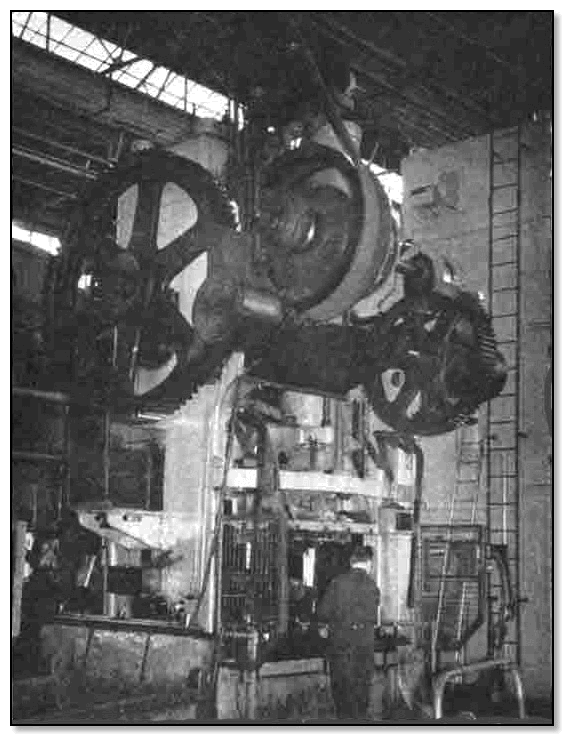West Press Shop (1950s)
Congestion and clamour betray the activity in the Main Shop
Have you ever stopped to think, as you admire your dream car resplendent in a brightly lit show-room, how its sleek body has been formed out of plain sheets of cold steel? It gives little indication of the amount of intensive work and careful planning that has gone into its manufacture. The bodies for most Austin cars arc assembled with at least one main pressing formed in the West Works Press Shop at Longbridge. This shop, employing 220 men, is a self contained establishment concerned with the shaping of about 2,000 different types of pressings, and assists the two giant firms Fisher and Ludlow and The Pressed Steel Co., Ltd. In their gigantic task of supplying body parts for all Austin cars. Sheets of metal arrive by road from the steel manufacturers, such as The Steel Co. of Wales Ltd. where they have been rolled. Before being accepted, the steel is tested by the works research laboratory for the qualities necessary for presswork. They are then placed in storage until required on the shop floor.
As would be expected, steel consumption is high, amounting to 700 tons per week of which up to 200 tons become scrap. This high scrap tonnage is because certain components have panels punched out of the middle and all components have waste metal in the form of ' flash ' round the edge. Flash is the metal left round the pressing and serves the dual purpose of allowing a slight excess of metal to ensure the dies are completely filled, and secondly to enable clamping of the sheet when metal has to be drawn into a deep section. After trimming, the waste metal is removed by crane and squeezed into large blocks weighing about four hundred-weight in a hydraulic baler. The bales are finally taken back to the steel works for remelting. The large shop holds 150 presses, ranging from the light 6-ton presses to the 1,000-ton giants which form the larger body panels. About half of these presses form chassis parts, whilst the remainder produce body panels. The majority of panels are for the Mini van, the A55 van, lorry cabs, and the Austin Healey 3000, which is assembled by Jensen Motors of West Bromwich. The presses arc immense machines reaching up to the roof of the building. Each machine is driven by a separate electric motor, the larger ones being about 80 h.p. Some of these machines are over forty years old and keep working year after year without much trouble. This is an important factor when the price of a new press may be as much as £26,000 and cost about £2,000 to install. For general work, i.e. cutting, piercing, bending and forming, single acting presses are used.
Larger work is carried out on the double acting presses which have two rams, one working inside the other. The outer ram descends first to cut the blank from the sheet and then dwells, holding the blank against the die face, while the inner ram descends further into the die forming the blank to the required shape. Two 500 ton hydraulic presses are used for deep drawing operations where the metal has to undergo severe deformation, such as an engine oil sump. The advantage of this press is that the pressure is applied gradually and uniformly, which is impossible with a crank mechanism. Owing to the old-fashioned and overcrowded layout of the shop floor, flow production is impossible and automatic handling of materials out of the question. Consequently the production is of batch type which introduces many difficulties. In very congested conditions, tools weighing up to 30 tons and materials are transported from press to press by overhead cranes. In this congested atmosphere work is carried out and new dies tried with the minimum of delay to the shop's production flow. It is significant that dies carefully manufactured by skilled hands give no indication of their worth until tried out in the press under working conditions. It is largely due to the wide variation in products and the batch type production that for every productive worker there is another worker necessary to maintain job flow.
Toolsetters are required to change die sets about 8,000 times a month and stingers and labourers are engaged in transporting the dies and materials from one end of the shop to the other. As the shop is so congested, special attention is paid to accident prevention. Safety guards are designed so that as the ram descends the operator is forced bodily away from the tool, thus reducing the chance of squashing fingers between the die faces. With these precautions in operation the Press shop has one of the best safety records in the Longbridge plant. With drive and determination the Press Shop holds its own against competition from the giant pressed steel firms. By applying its skill and knowledge the Press Shop has shown that it is equal to any task which may be set before it, and continues to build quality into Austin vehicles

A towering heavy press dwarfs its operator

